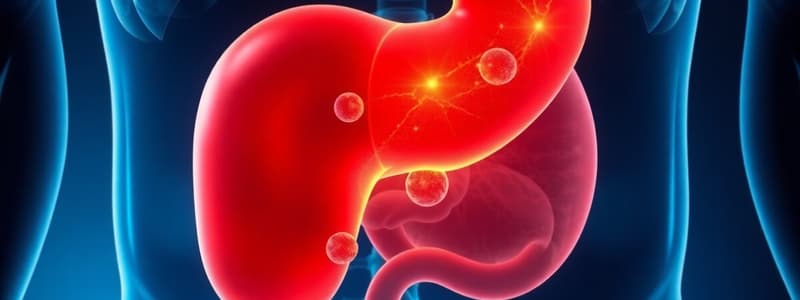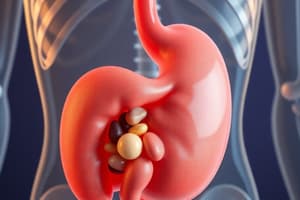Podcast
Questions and Answers
What is the typical duration of pain associated with cholecystitis?
What is the typical duration of pain associated with cholecystitis?
- 1 to 2 hours
- 6 to 12 hours
- 12 to 18 hours (correct)
- 30 minutes to 5 hours
Which symptom is specifically associated with acute cholelithiasis but not with cholecystitis?
Which symptom is specifically associated with acute cholelithiasis but not with cholecystitis?
- Chills and fever
- Anorexia
- Severe, steady pain localized to the epigastrium (correct)
- RUQ tenderness
What complication can arise from cholelithiasis?
What complication can arise from cholelithiasis?
- Cholecystitis
- Common bile duct obstruction (correct)
- Empyema
- Perforation with peritonitis
Which of the following is a distinguishing feature of gallstone ileus compared to acute cholecystitis?
Which of the following is a distinguishing feature of gallstone ileus compared to acute cholecystitis?
What associated symptom is unique to cholecystitis that is not typically found in biliary colic (cholelithiasis)?
What associated symptom is unique to cholecystitis that is not typically found in biliary colic (cholelithiasis)?
Which clinical manifestation is common to both cholangitis and choledocholithiasis?
Which clinical manifestation is common to both cholangitis and choledocholithiasis?
What is a common treatment for cholecystitis when laparoscopic surgery is not an option?
What is a common treatment for cholecystitis when laparoscopic surgery is not an option?
Which symptom is least likely to be associated with biliary colic?
Which symptom is least likely to be associated with biliary colic?
What is an essential component of therapy for both cholangitis and choledocholithiasis?
What is an essential component of therapy for both cholangitis and choledocholithiasis?
Which of the following is NOT a clinical manifestation of cholecystitis?
Which of the following is NOT a clinical manifestation of cholecystitis?
Study Notes
Cholelithiasis and Cholecystitis
- Cholelithiasis: Presence of gallstones in the gallbladder
- Cholecystitis: Inflammation of the gallbladder, often caused by a gallstone blocking the cystic duct
Manifestations
- Cholelithiasis:
- Pain: Abrupt onset, severe, steady, localized to the epigastrium and right upper quadrant (RUQ) of the abdomen, may radiate to the back, right scapula, and shoulder. Lasts 30 minutes to 5 hours.
- Associated Symptoms: Nausea, vomiting, RUQ tenderness and guarding
- Cholecystitis:
- Pain: Abrupt onset, severe, steady, generalized in the RUQ of the abdomen, may radiate to the back, right scapula, and shoulder. Lasts 12-18 hours. Aggravated by movement and breathing.
- Associated Symptoms: Anorexia, nausea, vomiting, RUQ tenderness and guarding, chills, and fever.
Complications
- Cholelithiasis:
- Cholecystitis:
- Common bile duct obstruction: May lead to jaundice (yellowing of the skin and eyes) and liver damage
- Common duct obstruction with pancreatitis: Inflammation of the pancreas
- Gangrene and perforation: Necrosis of the gallbladder, may result in peritonitis (inflammation of the peritoneum, the lining of the abdominal cavity)
- Chronic cholecystitis: Persistent inflammation of the gallbladder
- Empyema: Collection of pus within the gallbladder
- Fistula formation: Abnormal connection between the gallbladder and other organs
- Gallstone ileus: Gallstone blocking the small intestine
Biliary Colic
- Etiology: Gallstone blocking the cystic duct
- Clinical Manifestations: Severe steady ache in RUQ that begins suddenly and lasts for several hours, may radiate to the right scapula or back, nausea, vomiting, fat intolerance
- Clinical Therapies:
- Analgesics
- Adequate rest
- Adequate nutrition
- Correction of electrolyte imbalances
- Antiemetics
Cholecystitis
- Clinical Manifestations: RUQ or epigastric pain that progressively worsens, anorexia, nausea, vomiting, fever, chills, fat intolerance
- Clinical Therapies:
- Analgesics
- Adequate rest
- Adequate nutrition
- IV antibiotic therapy
- Antiemetics
- Laparoscopic surgery, which may convert to open surgery with possible T-tube placement
- If surgery is contraindicated or the condition is chronic, oral dissolution therapy or lithotripsy
Choledocholithiasis
- Etiology: Gallstone in the common bile duct
- Clinical Manifestations: RUQ pain, fever, jaundice, pruritus (itching), abdominal tenderness
- Clinical Therapies:
- Analgesics
- Antihistamines
- Adequate nutrition
- IV antibiotic therapy
- Antiemetics
- Surgery
Cholangitis
- Etiology: Infection of the bile ducts
- Clinical Manifestations: RUQ pain, fever, jaundice, pruritus, abdominal tenderness, clay-colored stools, dark urine, low blood pressure, lethargy
- Clinical Therapies:
- Analgesics
- Antihistamines
- Adequate nutrition
- IV antibiotic therapy
- Antiemetics
- Surgery
Studying That Suits You
Use AI to generate personalized quizzes and flashcards to suit your learning preferences.
Description
This quiz covers the essential aspects of cholelithiasis and cholecystitis, including their definitions, manifestations, and complications. Test your knowledge on the symptoms, pain characteristics, and potential complications associated with gallstones and gallbladder inflammation.




